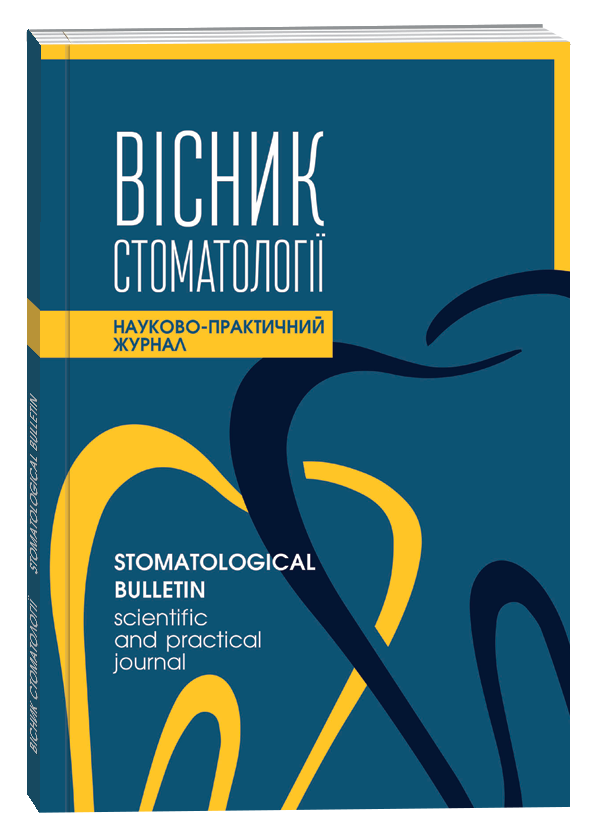ANALYSIS OF THE RISK FACTORS PROMOTING DEVELOPMENT OF CHRONIC CATARRHAL GINGIVITIS IN CHILDREN SUFFERING FROM SIMPLE DIFFUSE GOITER
DOI:
https://doi.org/10.35220/2078-8916-2022-44-2.14Keywords:
simple diffuse goiter, children, chronic catarrhal gingivitis.Abstract
A leading etiopathologic factor promoting the development of an inflammatory process in the gums is oral microflora which realizes its pathogenic action in case favorable local and general conditions are created [1; 2]. As a rule, these conditions in children are caused by excessive dental deposits due to both inadequate oral hygiene, lesions of the hard dental tissue available, and occlusive disturbances etc. Disorders of the protective mechanisms, metabolic and regulating processes in the child’s organism play an important role as well, which is the subject of our research [3; 4]. To understand the issue comprehensively we have analyzed the major local risk factors promoting the development of gingivitis in children, estimated alimentary, social-behavioral and preventive measures in the groups of observation. Objective: to determine risk factors promoting the development of chronic catarrhal gingivitis in children suffering from simple diffuse goiter (SDG). Materials and methods. With the aim to find these factors we have examined two age groups 12 and 15 years of age including 180 children suffering from SDG and 80 somatically healthy children. Conclusion. The course of chronic catarrhal gingivitis in children with underlying simple diffuse goiter is characterized by the following periodontal-pathogenic factors available: semi-solid and solid dental deposits, lesions of the hard dental tissues, defects of separate teeth, irrational nutrition and lack of preventive measures. At the same time, the action of these factors is equally strong both in somatically healthy children and those suffering from SDG, which is evidenced by little reliable difference in the groups of observation.
References
Малий Д. Ю., Антоненко М. Ю. Епідеміологія захворювань пародонта: віковий аспект. Український науково-медичний молодіжний журнал. 2013. № 4. С. 41–3.
Каськова Л. Ф., Бережна О. Е., Новікова С. В. Проблеми виникнення хронічного катарального гінгівіту у дітей та шляхи їх вирішення. Полтава : ТОВ НВП «Укрпромторгсервіс», 2015. 86 с.
Остапко О. І. Стан тканин пародонта у дітей та підлітків, які проживають у різних регіонах України. Новини стоматології. 2015. № 1 (82). С. 78–83.
Хоменко Л. О., Біденко Н. В., Остапко О. І., Голубєва І. М. Дитяча пародонтологія: стан проблем у світі та Україні. Новини стоматології. 2016. № 3 (88). С. 67–71.
Roberts M. W. Dental health of children: where we are today and remaining challenges. J Clin Pediatr Dent. 2008. № 32 (3). Р. 231–4.
Davidovic B., Ivanovic M., Jancovic S., Lecic J. The assessment of periodontal health in children age 12 to 15. Serbian Dent J. 2012. № 59 (2). Р. 83–9.
Сущенко А. В., Лепехина О. А., Лепехина Л. И. Результаты исследования распространѐнности патологии пародонта у детей. Международный журнал экспериментального образования. 2015. № 5. С. 41–2.
Veiga K. A., Porto A. N., Matos F. Z., et al. Caries Experience and Periodontal Status in Children and Adolescents with Cleft Lip and Palate. Pediatr Dent. 2017. № 39 (2). Р. 139–144.
Kaur A., Gupta N., Baweja D. K., Simratvir M. An epidemiological study to determine the prevalence and risk assessment of gingivitis in 5-, 12- and 15-year-old children of rural and urban area of Panchkula (Haryana). Indian J Dent Res. 2014. № 25 (3). Р. 294–99.
Moreau A. M., Hennous F., Dabbagh B., Ferraz Dos Santos B. Oral Health Status of Refugee Children in Montreal. J Immigr Minor Health. 2019. № 21 (4). Р. 693–98.
Цепов Л. М., Михеева Е. А., Голева Н.А, и др. Хронический генерализованный пародонтит: ремарки к современным представлениям. Пародонтология. 2010. № 1 (54). С. 3–7.
Грудянов А. И., Фоменко Е. В. Этиология и патогенез воспалительных заболеваний пародонта. Москва : МИА; 2010. 96 с.









